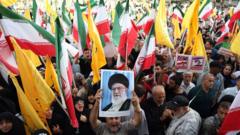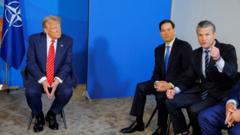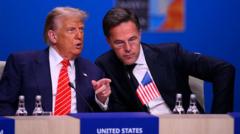During the recent NATO summit in The Hague, leaders reached a tentative agreement regarding defense spending, setting a goal for member nations to allocate 5 percent of their Gross Domestic Product (GDP). However, the phrasing in the summit's final communiqué has raised questions about the commitment level of individual countries, as it uses the term “allies" rather than “all allies,” allowing for varying interpretations of the agreement.
NATO Leaders Tackle Defense Spending Amid Mixed Reactions

NATO Leaders Tackle Defense Spending Amid Mixed Reactions
Discussions at the NATO Summit lead to a controversial spending agreement reflecting ongoing diplomatic tensions.
President Trump, who has long advocated for increased military spending among member states, claimed that most allies would meet the 5 percent target. His criticism focused particularly on Spain, which lags behind with an expenditure of 1.28 percent of GDP. This heated rhetoric came amidst ongoing discussions over a potential trade deal with Spain, where Trump promised to ensure they would "pay twice as much."
The final wording of the communiqué was crafted as a compromise, a bid to maintain unity among members despite underlying disagreements and different national priorities. Notably, this subtle diplomatic maneuver reflects broader challenges within NATO concerning defense expenditures and collaborative commitment, illustrating the balance between public agreement and private dissent among member states.
The final wording of the communiqué was crafted as a compromise, a bid to maintain unity among members despite underlying disagreements and different national priorities. Notably, this subtle diplomatic maneuver reflects broader challenges within NATO concerning defense expenditures and collaborative commitment, illustrating the balance between public agreement and private dissent among member states.























